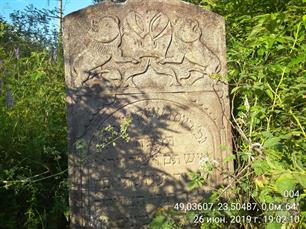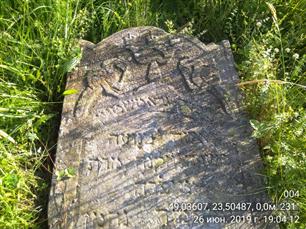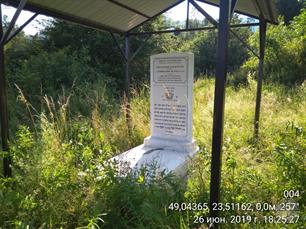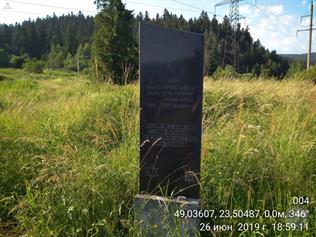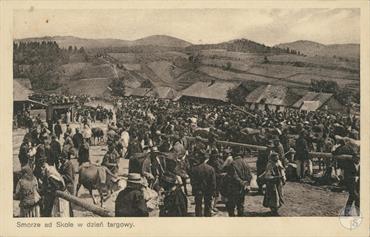Skole
Stryy district, Lviv region
Sources:
- Virtual Shtetl. Skole
- Jewish encyclopedia of Brockhaus & Efron
- Słownik geograficzny Krуlestwa Polskiego i innych krajow słowiańskich, vol. 10, eds. F. Sulimierski, W. Walewski, B. Chlebowski, Warsaw, p. 688.
- Encyclopedia of Jewish Life Before and During the Holocaust, vol. 3, eds. S. Spector, G. Wigoder, New York 2001, pp. 1193–1194.
- Wikipedia. Skolya (Hasidic dynasty)
Photo:
- Jewish Cemeteries Initiative. Skole Jewish Cemetery
- Center for Jewish art. Skole
- Biblioteka Narodowa Polona. Skole
- Wikipedia. Сколівська громада
- Virtual Shtetl. Skole
- Jewish encyclopedia of Brockhaus & Efron
- Słownik geograficzny Krуlestwa Polskiego i innych krajow słowiańskich, vol. 10, eds. F. Sulimierski, W. Walewski, B. Chlebowski, Warsaw, p. 688.
- Encyclopedia of Jewish Life Before and During the Holocaust, vol. 3, eds. S. Spector, G. Wigoder, New York 2001, pp. 1193–1194.
- Wikipedia. Skolya (Hasidic dynasty)
Photo:
- Jewish Cemeteries Initiative. Skole Jewish Cemetery
- Center for Jewish art. Skole
- Biblioteka Narodowa Polona. Skole
- Wikipedia. Сколівська громада
Skole (Ukrainian: Скoле) is a town in Lviv region. The first official date recorded for Skole was in 1397.
A great influence on the economy and cultural development of the region was Baron Groedl and his family. In Skole, the coins of Baron Groedl were used. They were minted at Vien, a mint which continued to be in use until 1930.
Skole received its Magdeburg rights in 1397, by a decree of King Wladyslaw Jagiello. Until 1772, the town belonged to the Lviv Land, Ruthenian Voivodeship of the Kingdom of Poland. Following the Partitions of Poland, it was annexed by the Habsburg Empire, as part of Austrian Galicia, where Skole remained until 1918. In the interbellum period, it was part of Stryj County, Stanislawow Voivodeship, with population divided between Jewish, Polish and Ukrainian communities, also Germans and Czechs.
A great influence on the economy and cultural development of the region was Baron Groedl and his family. In Skole, the coins of Baron Groedl were used. They were minted at Vien, a mint which continued to be in use until 1930.
Skole received its Magdeburg rights in 1397, by a decree of King Wladyslaw Jagiello. Until 1772, the town belonged to the Lviv Land, Ruthenian Voivodeship of the Kingdom of Poland. Following the Partitions of Poland, it was annexed by the Habsburg Empire, as part of Austrian Galicia, where Skole remained until 1918. In the interbellum period, it was part of Stryj County, Stanislawow Voivodeship, with population divided between Jewish, Polish and Ukrainian communities, also Germans and Czechs.
In 1939, the town found itself under Soviet occupation, which put an end to the economic and social life of the Jews. At the beginning of July 1941, Hungarian troops allied with the Third Reich entered Skole, and a month later the Germans seized the town. Shortly afterwards, the Jewish Council (Judenrat) was formed. It served to meet the demands of the occupier. One of its tasks was to provide Germans with men between the ages of 14 and 60 to perform forced labour.
In December 1941, 20 Jewish sawmill workers were declared unfit for work and murdered in a forest. This was the first signal of the new anti-Jewish order. Less than a year later, in September 1942, German authorities issued an order according to which Jews from the whole district were to be concentrated in several locations before the end of October: Stryj, Bolechуw (Bolekhiv), Chodorуw (Khodoriv), Skole, and Żurawno (Zhuravne).
On 2-4 December 1942, a liquidation Aktion was carried out, during which ca. 100 disabled Jews were killed in the town, and those who were considered “unproductive” were sent to Stryj and from there to the death camp in Bełżec. Most of the 900 people remaining in Skole were transferred to two labour camps that were liquidated in June and August 1943.
Germans and the Ukrainians continued to search for Jews hiding in the surrounding forests.
In December 1941, 20 Jewish sawmill workers were declared unfit for work and murdered in a forest. This was the first signal of the new anti-Jewish order. Less than a year later, in September 1942, German authorities issued an order according to which Jews from the whole district were to be concentrated in several locations before the end of October: Stryj, Bolechуw (Bolekhiv), Chodorуw (Khodoriv), Skole, and Żurawno (Zhuravne).
On 2-4 December 1942, a liquidation Aktion was carried out, during which ca. 100 disabled Jews were killed in the town, and those who were considered “unproductive” were sent to Stryj and from there to the death camp in Bełżec. Most of the 900 people remaining in Skole were transferred to two labour camps that were liquidated in June and August 1943.
Germans and the Ukrainians continued to search for Jews hiding in the surrounding forests.
Jews started to settle in Skole at the beginning of the 18th century. Their population grew steadily.
In 1880, there were 1,380 Jewish people in the town, constituting ca. 67% of all inhabitants (2,047);
in 1910, despite further growth of the Jewish community, their share of the total population went down – the 3,099 Jews living in Skole made up 48% of the total population (6,425);
in 1938, there were 2,670 Jews living in Skole – ca. 34% of the local population.
Many Jews started to work in the wood industry from ca. 1840 on. About 100 people were employed in the largest Galician match factory.
The following description sheds some light on the matter: “In S[kole], there is the Lipschuetz’s matchmaking factory. On the other side of the town, there is a long row of factories using the power of water and processing raw material brought from the mountains”.
Jews were also engaged in dynamically developing trade.
In 1880, there were 1,380 Jewish people in the town, constituting ca. 67% of all inhabitants (2,047);
in 1910, despite further growth of the Jewish community, their share of the total population went down – the 3,099 Jews living in Skole made up 48% of the total population (6,425);
in 1938, there were 2,670 Jews living in Skole – ca. 34% of the local population.
Many Jews started to work in the wood industry from ca. 1840 on. About 100 people were employed in the largest Galician match factory.
The following description sheds some light on the matter: “In S[kole], there is the Lipschuetz’s matchmaking factory. On the other side of the town, there is a long row of factories using the power of water and processing raw material brought from the mountains”.
Jews were also engaged in dynamically developing trade.
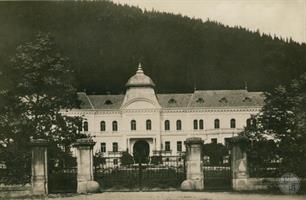 |
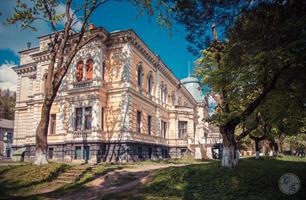 |
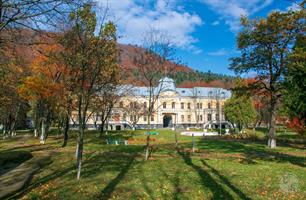 |
| Groedel Palace in Skole, ca 1930 | Groedel Palace in Skole, 2014 | Groedel Palace in Skole, 2017 |
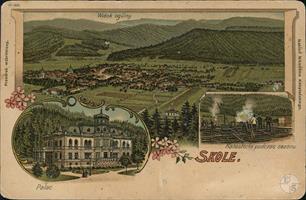 |
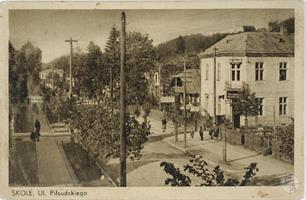 |
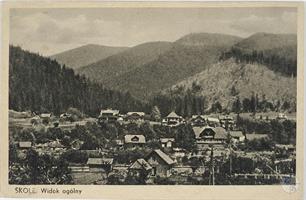 |
| Skole, before 1906 | Skole, Pilsudskoho street, 1939 | Skole, general view, 1939 |
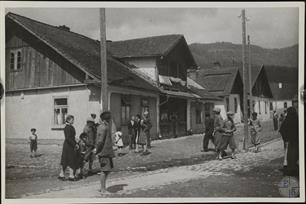 |
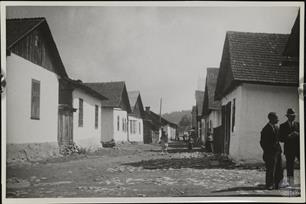 |
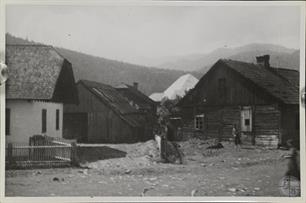 |
| Skole, street in the Jewish quarter. Photo of Józef Tężycki, 1937 | Skole, street in the Jewish quarter. Photo of Józef Tężycki, 1937 | Skole, street in the Jewish quarter. Photo of Józef Tężycki, 1937 |
At the end of the 19th century, the Hasidic dynasty was founded by Rebbe Eliezer Chaim Rabinowitz. Skolya dynasty is quite numerous and exists until today.
There were a wooden synagogue and school of the Baron Hirsh Foundation in Skole.
At the beginning of the 20th century, Zionists became the main political force among the Jewish community in Skole. Their dominance and versatile activity continued in the interwar period. The Agudath had influence only in traditionalist circles.
Near Skole, at the Denbina railway station (Dębina), was Ferienkolonie for poor Jewish children from Lviv.
In the 1930s, anti-Semitism intensified in Skole and entire Poland, resulting in numerous minor or more severe conflicts between the Polish and Jewish population.
There were a wooden synagogue and school of the Baron Hirsh Foundation in Skole.
At the beginning of the 20th century, Zionists became the main political force among the Jewish community in Skole. Their dominance and versatile activity continued in the interwar period. The Agudath had influence only in traditionalist circles.
Near Skole, at the Denbina railway station (Dębina), was Ferienkolonie for poor Jewish children from Lviv.
In the 1930s, anti-Semitism intensified in Skole and entire Poland, resulting in numerous minor or more severe conflicts between the Polish and Jewish population.

- Home
- Shtetls
- Vinnytsia region
- Volyn region
- Dnipro region
- Donetsk region
- Zhytomyr region
- Zakarpattia region
- Zaporizhzhia region
- Ivano-Frankivsk region
- Kyiv region
- Kropyvnytskyi region
- Luhansk region
- Lviv region
- Mykolayiv region
- Odessa region
- Poltava region
- Rivne region
- Sumy region
- Ternopil region
- Kharkiv region
- Kherson region
- Khmelnytskyi region
- Chernihiv region
- Chernivtsi region
- Cherkasy region
- Crimea
- Synagogues
- Cemeteries
- Objects & guides
- Old photos
- History
- Contact
Jewish towns of Ukraine
Jewish towns of Ukraine
My shtetl
My shtetl
Donate
